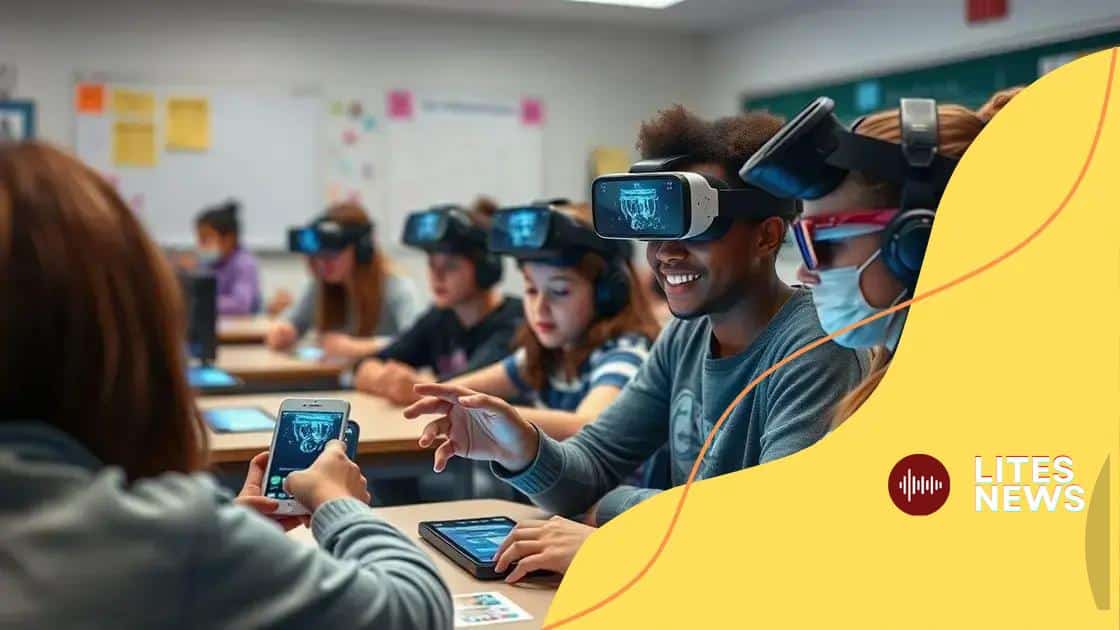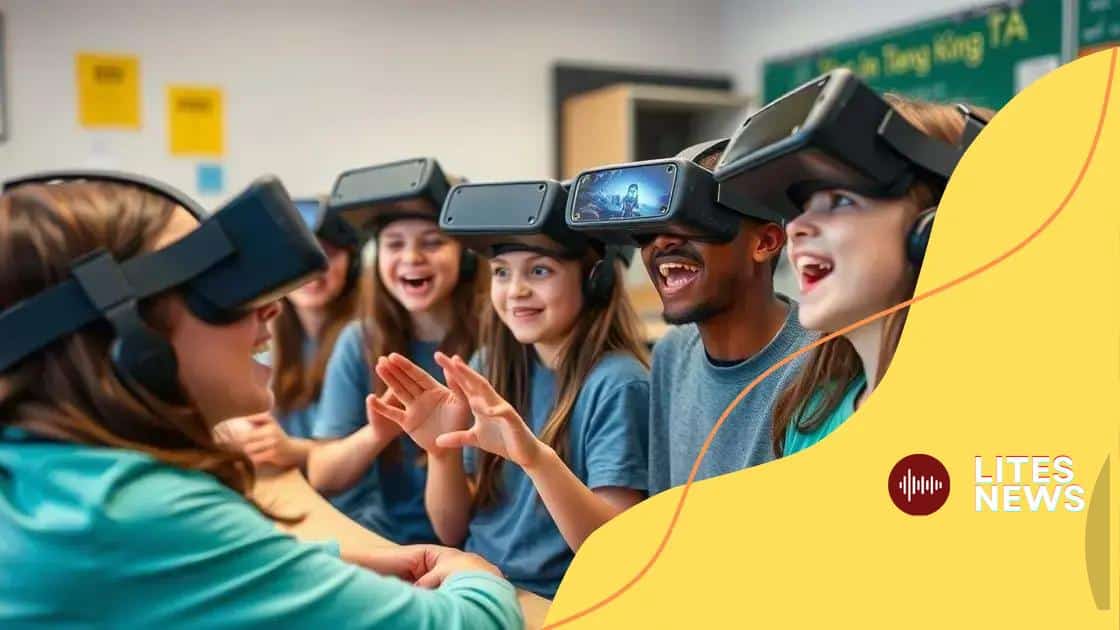How AR is being used for hands-on learning experiences

How AR is being used for hands-on learning experiences enhances education by increasing student engagement, simplifying complex subjects, and providing interactive, personalized learning opportunities.
How AR is being used for hands-on learning experiences is changing the landscape of education. Imagine a classroom where students can interact with 3D models or explore virtual environments. This technology opens up endless possibilities for learning.
Understanding augmented reality in education
Understanding augmented reality in education involves grasping how it can enhance learning experiences for students. This technology blends the digital world with our physical surroundings, making lessons more interactive and engaging.
What is Augmented Reality?
Augmented reality (AR) enriches real-world experiences by overlaying digital content onto our view of the physical world. Imagine learning about the solar system by seeing planets and stars floating right in your classroom!
Benefits of AR in Education
- Enhanced Engagement: Students are more likely to participate when lessons include AR technology.
- Interactive Learning: AR allows students to interact with 3D models, making complex subjects easier to understand.
- Personalized Experiences: Students can learn at their own pace, revisiting difficult topics as needed.
- Real-World Applications: AR provides practical applications that show students how their learning connects to the world outside the classroom.
Using AR not only captivates students but also encourages collaboration. Classmates can work together on projects, exploring subjects like biology through virtual dissection or history via immersive timelines. This form of learning fosters curiosity while enabling creativity.
Moreover, educators can use AR tools to create custom learning experiences. They can design lessons that align with students’ interests, making learning more relevant. For instance, a science lesson on ecosystems may involve AR interactions with animals and plants, igniting a passion for environmental science.
As schools adapt to new technologies, understanding augmented reality becomes essential. It is vital for teachers to stay updated on technological advancements to effectively incorporate them in classrooms. By embracing AR, educators prepare students for a future where digital fluency is crucial.
In summary, augmented reality offers a transformative approach to education. By making learning interactive and relatable, it equips students with the skills and enthusiasm needed for academic success.
Real-world applications of AR in hands-on learning
Real-world applications of augmented reality (AR) in hands-on learning showcase how this technology is transforming education. With AR, students engage in interactive experiences that deepen their understanding of complex topics.
Scientific Exploration
In science classes, AR can make learning about the human body thrilling. Students can visualize organs and systems in 3D, exploring how they function. This experience helps them grasp concepts that are often hard to visualize through books alone.
- Interactive Lab Simulations: AR can create virtual lab environments, allowing students to conduct experiments safely.
- Field Trip Alternatives: Through AR, students can virtually visit ecologically diverse locations, exploring ecosystems without leaving the classroom.
- Real-Time Data Interaction: Students can see real-time data on natural phenomena, enhancing their analytical skills.
AR is also making waves in history lessons. Students can interact with historical figures and view events as they unfolded. Imagine walking through a lifelike simulation of ancient Rome! Engaging with history in this way brings it to life and encourages students to develop a deeper appreciation for the past.
Mathematics and Geometry
Another area where AR shines is in mathematics. Students can visualize geometric shapes in a three-dimensional space, allowing for better comprehension of complex concepts like volume and area. Using AR, learners can manipulate shapes, which strengthens their spatial reasoning skills.
Furthermore, AR aids in skills-based learning such as mechanics and engineering. Students can use AR to assemble virtual machines or vehicles, experiencing the consequences of their designs in real-time. This hands-on approach fosters creativity while imparting practical skills.
Enhancing education through AR also promotes collaboration among students. Working in groups on AR projects encourages teamwork and communication, essential skills for future workplace environments. This camaraderie creates a community of learners who support each other’s growth.
Benefits of AR for student engagement

Benefits of AR for student engagement are significant and transformative. This technology offers unique experiences that keep students interested and excited about learning.
Increased Motivation
Using augmented reality in lessons makes learning fun and interactive. When students can visualize and interact with the content, they are more motivated to participate. Instead of passive learning, AR can spark curiosity and encourage exploration.
- Hands-On Learning: Students can engage with materials in ways they never could before, making complex subjects easier to grasp.
- Real-Time Feedback: AR allows students to receive immediate responses to their actions, which enhances their learning process.
- Visual Learning: Many students find it easier to learn through visual means, and AR provides dynamic graphics that reinforce understanding.
Furthermore, AR fosters collaboration among students. Learning experiences can include group tasks where students use AR tools together. This teamwork helps build social skills and promotes discussion, enriching the learning environment.
Personalized Learning Experiences
Another key benefit of AR is the ability to tailor learning experiences to individual needs. Teachers can create customized AR experiences that align with each student’s learning pace and style. This approach can help meet diverse learning requirements, allowing all students to succeed.
Moreover, AR has applications beyond traditional subjects. It can introduce students to new interests and career paths, sparking a passion for fields like science, technology, engineering, and mathematics (STEM). The real-world connections made through AR can inspire students to pursue further education and careers in these areas.
Ultimately, the benefits of augmented reality in education are clear. By enhancing motivation, promoting collaboration, and providing personalized learning experiences, AR prepares students for the future while making learning enjoyable.
Challenges in implementing AR in classrooms
Challenges in implementing AR in classrooms can hinder the potential of this exciting technology. Despite its benefits, schools face several obstacles when integrating augmented reality into their curricula.
Cost of Implementation
One major challenge is the cost associated with AR technology. Schools often have limited budgets for technology upgrades. Purchasing AR devices, software, and necessary infrastructure can be expensive. Additionally, training teachers to effectively use these tools incurs further costs.
- Device Accessibility: Not all students have access to personal devices needed for AR experiences.
- Software Licensing: Many AR applications require subscription fees, adding ongoing expenses.
- Maintenance Costs: Regular updates and maintenance of AR tools can strain school budgets.
Furthermore, teachers might lack the confidence or training to implement AR effectively. Professional development programs are necessary, but they require time and resources. Many educators feel unprepared to incorporate new technology into their teaching methods.
Curriculum Integration
Another significant obstacle is curriculum integration. Aligning augmented reality content with existing lesson plans can be tricky. Teachers must find ways to seamlessly blend AR with traditional teaching methods to enhance learning instead of complicating it.
Moreover, not all subjects lend themselves well to AR experiences. While science and math have clear applications, other areas may struggle to find relevant AR content. This inconsistency can lead to uneven adoption rates across subject areas.
Data privacy and security concerns also arise with implementing AR in the classroom. Many AR applications require data collection, raising questions about student privacy. Schools must ensure that data is handled responsibly, which can add another layer of complexity.
Overall, while there are exciting potential benefits of using augmented reality in education, schools must navigate challenges related to cost, training, curriculum integration, and privacy to leverage this innovative technology successfully.
Future trends of AR in education
Future trends of AR in education are expected to reshape how students learn and engage with content. As technology advances, new possibilities emerge that can enhance the educational experience.
Increased Accessibility
One significant future trend is increased accessibility. As AR technology becomes more affordable and widespread, more schools can implement it. This change will help bridge the gap between different learning environments, allowing students from various backgrounds to benefit.
- Affordable Devices: Advances in mobile technology may lead to cheaper AR devices, making them available to more students.
- Wider Resource Availability: Educational institutions will have access to more comprehensive AR content, covering various subjects.
- Integration with Other Technologies: AR will be increasingly integrated with other technologies, such as virtual reality (VR) and artificial intelligence (AI), creating richer learning experiences.
Additionally, there will be a focus on personalized learning experiences. Future AR applications will allow students to learn at their own pace, tailoring content to their individual needs. By analyzing student performance, AR platforms can adapt lessons, ensuring that each learner receives the support necessary for success.
Collaborative Learning Environments
Collaborative learning environments are set to evolve with augmented reality. Students will engage in shared AR experiences, promoting teamwork and communication skills. Virtual classrooms will enable learners to connect with peers worldwide, expanding perspectives and cultural understanding.
Moreover, educators will continue to innovate in their teaching methods. Future trends suggest that teachers will use AR to create immersive lessons that connect students with real-world applications. This hands-on approach will help students grasp complex concepts and their relevance to everyday life.
Lastly, the role of data and analytics will become vital in AR education. Educators will utilize data from AR interactions to better understand student progress. This information will help in refining teaching strategies and ensuring that instruction meets diverse learning needs.
FAQ – Frequently Asked Questions about Augmented Reality in Education
What are the main benefits of using AR in education?
AR enhances student engagement, motivation, and provides personalized learning experiences that make complex subjects easier to understand.
What challenges do schools face when implementing AR?
Schools face challenges such as high implementation costs, need for teacher training, and curriculum integration to effectively use AR technology.
How can AR improve collaboration among students?
AR allows students to work together on projects in immersive environments, enhancing teamwork and improving communication skills.
What future trends can we expect from AR in education?
Future trends include increased accessibility, personalized learning, and the integration of AR with other technologies to create richer educational experiences.





